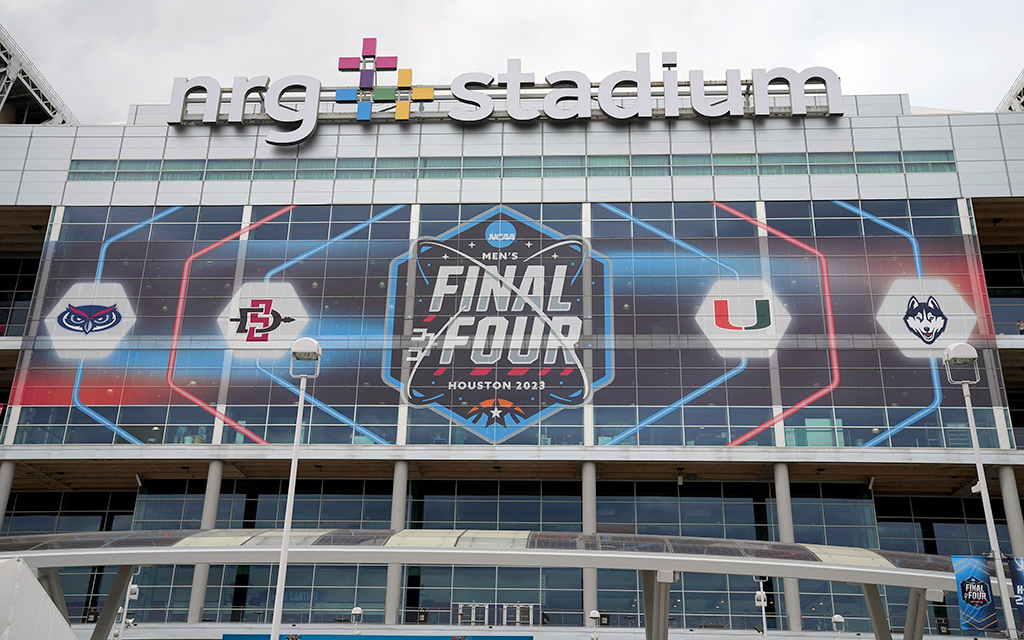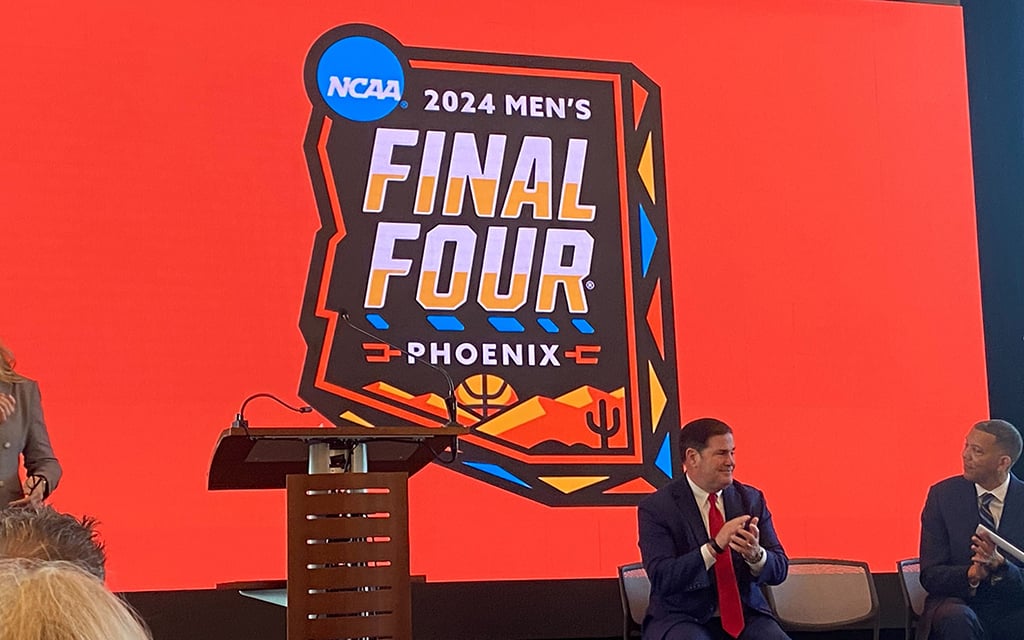
For the first time since 2017, the Valley will host the Final Four next year at State Farm Stadium on April 6 and April 8. (Photo by Mitchell Layton/Getty Images)
HOUSTON – After six years, the Final Four is returning to Arizona. Since the biggest event in college basketball last took place here, the Valley of the Sun has hosted an NBA Finals, an MLB wild-card game, a Super Bowl and the annual WM Phoenix Open.
With the constant carousel of sporting events, one city knows how to maximize the benefits: Houston. The city has hosted four men’s Final Fours, two Super Bowls and the yearly Texas Bowl. A Harris County official recently projected at least a $270 million economic impact for Houston for this year’s tournament, a number that Arizona is looking to match, or even exceed.
The Harris County Sports Authority took responsibility for the development and economic side of the Final Four. It oversees sports venues and promotes the region for sports-related events, which enhance economic development and bring a better quality of life to residents, according to the company’s mission statement.
Janis Burke, the president of the Harris County Sports Authority, understands the importance of how an event like this has a powerful effect on the economy.
“I would say, as far as businesses go, you’re looking at restaurants, you’re looking at airline carriers and transportation companies; whether it’s taxis, Uber, Lyft, those kinds of companies, everybody that kind of feeds off of the sports tourism industry. It’s really great for the whole community,” Burke said.
Much like sports, having the perfect fit is ideal for events like the Final Four. The revenue generated from the biggest tournament in college basketball is significant. A report from the W.P Carey School of Business at Arizona State University stated that the estimated total economic impact for the 2017 Final Four in Arizona was $324.5 million.
It’s a relatively high mark, considering two years earlier the Grand Canyon State hosted Super Bowl XLIX that brought in $719.4 million and generated $273.6 million from the 2016 College Football Playoff Championship game.
The generated revenue from these events isn’t solely put into the businesses’ pockets. The money goes into other areas that desperately need it. Burke recognizes what the economic impact of these events do to the city to touch up areas in need.
“It’s happened as far as new floors and facilities that desperately need it, for kids that are at risk and that need just that extra adult support in their life,” Burke said. “We’ve had several of those types of projects.”
Local organizing committees are the backbone of a successful event like the Final Four. They provide Congress and organizers with advice on every aspect of coordinating the event in areas like the program, logistics, sponsoring, venue, security and accommodation.
One of these projects was the “Read to the Final Four” contest, where schools within the Houston Independent School District were to read as many minutes from a book as possible. The winner of the competition would take their school to the Final Four and watch the game.
These community events not only help bring people together but also help bring people to the games. For example, the 2017 Final Four featured the most watched semifinal games since the 1998 Final Four. The Oregon-North Carolina and Gonzaga-South Carolina matchups drew an average of 16.8 million viewers, an increase in viewership of 44% over the previous year.
Dan Marburger, an Arizona State University clinical economics professor, believes the economic impact might not be all that it’s cracked up to be, at least from locals.
“If I’m a resident in Phoenix, I still spend my money,” he said. “I don’t throw it away, so the economic impact has to be overstated. Now, what Phoenix does have as an advantage for something like the Final Four, or the Super Bowl is a pleasant winter.
“So if you live in Minnesota, you live in Chicago, you can come to Arizona and get nicer weather. For example, I won’t have to wear a winter coat, so this would be cool so we have that as part of the enticement.”
Marburger talked about the “displacement effect,” which is essentially prices rising because of an event like the Final Four coming to Arizona. As a result, hotels such as the Sheraton and Hyatt Regency are expected to raise their prices because people will pay the price.
During the Final Four in Houston, the price for the Comfort Suites near NRG Stadium was roughly $1,300 total for a four-night stay. Two weeks later, a four-night stay was $392. Marburger shared an anecdote about his experience with the upcharge in prices surrounding a big sporting event.
“When I first moved here (in 2015) we had the Super Bowl,” he said. “When I moved here, I wanted to fly my parents out to visit. The only weekend that was going to work for us was Super Bowl weekend. We weren’t going to go to the game. But this was the only weekend that worked. So I thought, ‘OK, let me get online to buy tickets.’
“Well, tickets doubled in price. So had it not been for the Super Bowl, I would have flown my parents and we would have spent some money locally. But because of the Super Bowl, they didn’t come at all.”
Although the Super Bowl brings in significantly more revenue than the Final Four, the surplus of out-of-state visitors cannot be ignored. However, one of the biggest reasons the Final Four is heading back to the Valley is attendance. According to the Arizona Office of Tourism, the 2017 national semifinals and championship game in the Valley drew the second-highest attendance in NCAA history, with crowds of 77,612 and 76,168 for the semis and championship, respectively.
The Final Four attendance record is still 79,238 at AT&T Stadium in Arlington, Texas, in 2014. One of the key elements, though, is that these three cities are in the top 10 of highest populations. As simple as it sounds, that is part of what drives the NCAA to these cities.
Debbie Johnson, the former director of the Arizona Office of Tourism, believes the financial impact of the Final Four has significant lingering effects on the state.
“For us, we look at it a little bit longer term, in addition to the short term,” she said. “I think it’s hard to calculate what that success is from an economic impact, because who knows whether they will come next year or five years from now?
“But we do know people come and we have people in our industry tell us all the time, ‘Oh, someone came who we just saw, and they will watch us at the Final Four in 2017 and they went up to Sedona or they went to the Grand Canyon.’ Those are the kinds of stories we love to hear.”
The community rallying together is always a welcome sight in the eyes of Burke. Before seeing the transformation of a city, there are a multitude of questions she answers before going all-in to plan for an event like the Final Four. She described the questions that not just her county but others across the country strive to answer when planning for an event like the Final Four.
“Deeper for us is really, ‘How can we put a Houston fingerprint on this? What’s the media value? What kind of legacy does it leave for our community? And why should we spend our time on this? What is it going to do for our local citizens that another event can’t do?’ Burke said.
“So we really dive into that to really figure out if this is one that we think Houston is perfect for hosting and if it’s a good fit.”


